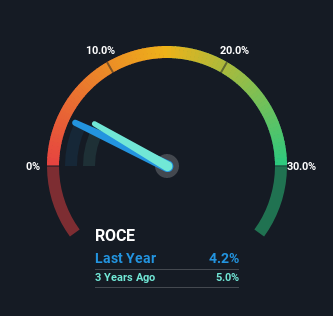Slowing Rates Of Return At NorthWestern (NASDAQ:NWE) Leave Little Room For Excitement
If we want to find a potential multi-bagger, often there are underlying trends that can provide clues. Firstly, we'd want to identify a growing return on capital employed (ROCE) and then alongside that, an ever-increasing base of capital employed. This shows us that it's a compounding machine, able to continually reinvest its earnings back into the business and generate higher returns. Although, when we looked at NorthWestern (NASDAQ:NWE), it didn't seem to tick all of these boxes.
Return On Capital Employed (ROCE): What is it?
For those that aren't sure what ROCE is, it measures the amount of pre-tax profits a company can generate from the capital employed in its business. To calculate this metric for NorthWestern, this is the formula:
Return on Capital Employed = Earnings Before Interest and Tax (EBIT) ÷ (Total Assets - Current Liabilities)
0.042 = US$269m ÷ (US$6.8b - US$380m) (Based on the trailing twelve months to December 2021).
Thus, NorthWestern has an ROCE of 4.2%. On its own, that's a low figure but it's around the 4.6% average generated by the Integrated Utilities industry.
View our latest analysis for NorthWestern
Above you can see how the current ROCE for NorthWestern compares to its prior returns on capital, but there's only so much you can tell from the past. If you'd like, you can check out the forecasts from the analysts covering NorthWestern here for free.
What Can We Tell From NorthWestern's ROCE Trend?
There are better returns on capital out there than what we're seeing at NorthWestern. The company has employed 31% more capital in the last five years, and the returns on that capital have remained stable at 4.2%. Given the company has increased the amount of capital employed, it appears the investments that have been made simply don't provide a high return on capital.
Our Take On NorthWestern's ROCE
As we've seen above, NorthWestern's returns on capital haven't increased but it is reinvesting in the business. And investors may be recognizing these trends since the stock has only returned a total of 22% to shareholders over the last five years. Therefore, if you're looking for a multi-bagger, we'd propose looking at other options.
One final note, you should learn about the 4 warning signs we've spotted with NorthWestern (including 1 which is potentially serious) .
If you want to search for solid companies with great earnings, check out this free list of companies with good balance sheets and impressive returns on equity.
Have feedback on this article? Concerned about the content? Get in touch with us directly. Alternatively, email editorial-team (at) simplywallst.com.
This article by Simply Wall St is general in nature. We provide commentary based on historical data and analyst forecasts only using an unbiased methodology and our articles are not intended to be financial advice. It does not constitute a recommendation to buy or sell any stock, and does not take account of your objectives, or your financial situation. We aim to bring you long-term focused analysis driven by fundamental data. Note that our analysis may not factor in the latest price-sensitive company announcements or qualitative material. Simply Wall St has no position in any stocks mentioned.

